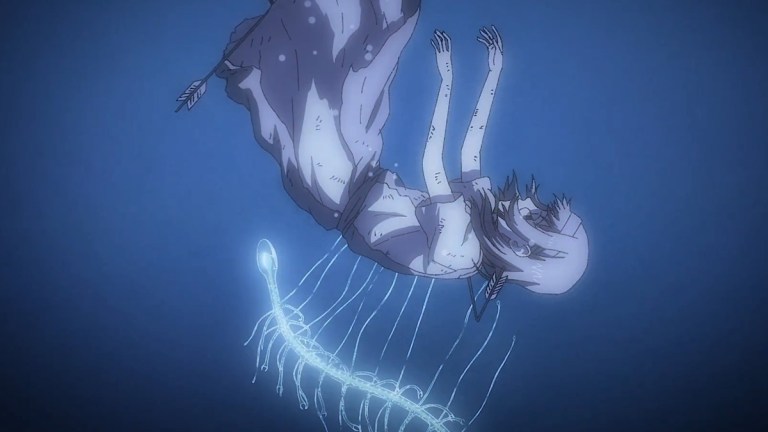Attack on Titan: What is The Shining Centipede?
Call it The Source of All Living Matter, The Devil of All Earth, or even Centipede-kun if you want. Attack on Titan’s Shining Centipede unlocks the story’s past and blazes a path to the endgame.

This article contains major spoilers for the Attack on Titan manga.
Titans are weird, even by anime monster standards. They look like people, if by people you mean eerily distorted caricatures made by deranged five year olds. Even the laws of thermodynamics that anchor the real universe in place are nothing more than a set of vague guidelines where they’re concerned. Titans are ghastly, peculiar, and thoroughly disturbing, but they’re not half as supernatural as the anomaly that brought them into existence.
The Shining Centipede, or Centipede-kun as it’s affectionately known to fans, is the insectoid entity that grants Ymir Fritz the Power of the Titans. The previous episode of Attack on Titan reveals this enigmatic organism to be the origin point of all Titankind, subverting the previously held belief that Ymir had made a deal with The Devil of All Earth.
The Origin Of The Titans
In “From You, 2,000 Years Ago”, Ymir ventures into the cavernous hollow at the base of a supermassive tree, loses her footing, and plunges into a body of subterranean liquid. She doesn’t drown — a luminous creepy-crawly swims up, tacks its tendrils to her spinal cord, and the first Titan emerges from a pillar of burning light.
The rest of the episode goes on to explain how the Eldian King Fritz exploits Ymir’s Titan to inflict his martial authority on the surrounding nations, particularly Marley. Thirteen years later, Ymir is killed by an assassin’s spear aimed at the king, but the latter ensures her powers are transferred to her descendants. Ymir’s daughters, Maria, Rose, and Sheena are forced to consume “every last scrap” of her dissected corpse, eventually giving rise to the Nine Titans. The translucent spine-worm reappears at the end of the episode, popping out of Eren’s neck and reassembling his recently decapitated body.
What We Know About The Source Of All Organic Matter
The first clue to the creature’s existence is dropped by Eren Kruger in season 3. He suggested that Ymir the Founder was neither divine nor demonic, but an ordinary person who accidentally came across the “Yūkibutsu no Kigen” — the Source of All Organic Matter. This belief in her ordinariness is reiterated by Eren Yeager in “From You, 2,000 Years Ago”, in his bid to emancipate Ymir from her multi-millennial slavery. Although both Erens (Kruger & Yeager) have the same socio-political epiphany, they fail to comprehend the exact nature of the Power of the Titans.
Gabi Braun refers to it as a Shining Centipede in Chapter 136 of the manga, indicating that it could be the Founding Titan itself. In 137, Zeke Yeager interprets it as a form of life that has survived for eons “because it was in its nature to multiply.” Jean Kirstein later activates the dynamite on the cervical vertebrae extending from Eren’s Founding Titan, releasing the Shining Centipede for the last time. Reiner grapples it to the ground while Armin transforms into the Colossus Titan, destroying the Founding Titan but leaving the creature intact.
Centipede-kun, now considerably chunkier than before, fumigates the area with a cloud of mystical smoke, turning hundreds of nearby humans into Pure Titans. The Armored, Cart, and Female Titans battle the Centipede and its new Titan army, nearly losing their lives in the process. However, this act of bravery allows Armin to immobilize Eren’s Colossus Titan, Levi to blast a hole through its teeth, and Mikasa to end the genocide by beheading the love of her life. The Shining Centipede is promptly incinerated, taking with it the Power of the Titans.
Scientific (Non)Arguments For The Shining Centipede
Pseudoscience is rampant in Attack on Titan, but the fact that nobody in the story knows anything about the Source of All Organic Matter makes it a source of enormous confusion. Thankfully, this hasn’t stopped readers from hatching potential theories ranging from the inane to the insightful. I have borrowed a few of them to shape my understanding of this baffling concept.
Despite countless arguments to the contrary, the Shining Centipede is biologically unfeasible. For starters, it displays advanced abilities that seem more in line with cutting-edge alien technology than what ancient worms were capable of. Centipede-kun can apparently graft itself onto the human nervous system, consequently providing its host with an array of superpowers. It presumably generates the Paths, a network of quasi-magical channels centered around the so-called Co-ordinate. These Paths function as neural circuits that link every Eldian person (and Titan), a sophisticated mainframe that can store, modify, and transfer collective memories according to the will of the Founding Titan’s user.
My favorite tinfoil theory assumes that Centipede-kun is indeed the precursor of all life because that would explain why Titans exhibit both plant and animal properties. As mentioned earlier, their external anatomy is distinctly humanoid — they have hair, skin, limbs, and all the normal facial features in all the right positions, although they lack genitalia. (Abnormal Titans vary slightly from this model.) On the other hand, Titans derive their energy from the sun and are generally dormant in the absence of solar radiation, much like photosynthetic plants. Some Titans respond to mild sensory stimuli (most animals), while others don’t even perceive extreme injuries (most plants).
The Shining Centipede also possesses some kind of sentience, given that it can act on its own accord when required. However, it seems to be permanently bound to the will of the first Founder, Ymir Fritz — it vanishes only after she decides to ditch her sandy limbo for good (in the final chapter). It could be that the Centipede “chooses” Ymir as its “partner,” and is either reluctant or unable to persist without her, but its disappearance is riddled with discrepancies.
Mythological References In The Shining Centipede
A few fans have suggested that the Shining Centipede’s original habitat, the subterranean pool nestled in the roots of the mega tree, signifies the hypothetical primordial soup that spawned the first life-forms on Earth. This conjecture is interesting, since Centipede-kun’s Titan-izing ability might account for the unnaturally large tree above the pool, but ultimately fruitless as there is not enough information to confirm or deny the scientific possibility.
Norse mythology offers far better support for the primordial pool hypothesis. The arcane liquid “eitr” is the source of life — Ymir, the progenitor of the giant-like beings known as the jötnar, is claimed to have originated from this substance. Interestingly, the Icelandic, Norwegian, Swedish, and Danish descendants of the word “eitr” refer to poison/venom, arguably mirroring the toxic impact of Titan warfare.
Another perspective within the same mythos mentions Nidhogg, a serpentine beast that represents chaos and suffering. This entity is found in Hvergelmir, a boiling spring located at the roots of Yggdrasil, the cosmic world tree that nourishes the nine realms of Midgard, Vanaheim, Utgard, Nidavellir, Hel, Asgard, Muspelheim, Svartalfheim, and Alfheim (the Nine Titans). The Poetic Edda further hints that the Norse apocalypse, Ragnarök, will be instigated by Nidhogg’s destruction of Yggdrasil’s primary root system and subsequent escape.
The Shining Centipede reflects the basic beats of Nidhogg’s narrative pattern — it slithers out from under its tree and wreaks eighteen centuries of havoc, before triggering a global holocaust in the form of the Rumbling. However, the ending of the world isn’t as macabre as it sounds in either Norse mythology or Attack on Titan because it may also refer to fresh beginnings for those who come after the apocalypse.
Does The Shining Centipede Make A Tangible Difference To The Story?
It’s difficult to rule out the likelihood of similar entities littered across the world, perhaps biding their time for gullible hosts to fall into their slimy clutches, but there’s only one that matters in Hajime Isayama’s masterpiece. In the end, it doesn’t matter if Centipede-kun is magical, biological, or a metaphor gone rogue — deus ex machinas are painfully common in manga/anime and Attack on Titan is no exception. What matters is the symbolic parallel between the Shining Centipede and the Eldian freedom struggle: that life will stubbornly continue to spread and flourish even when, or especially because, its survival hangs by a thread.
